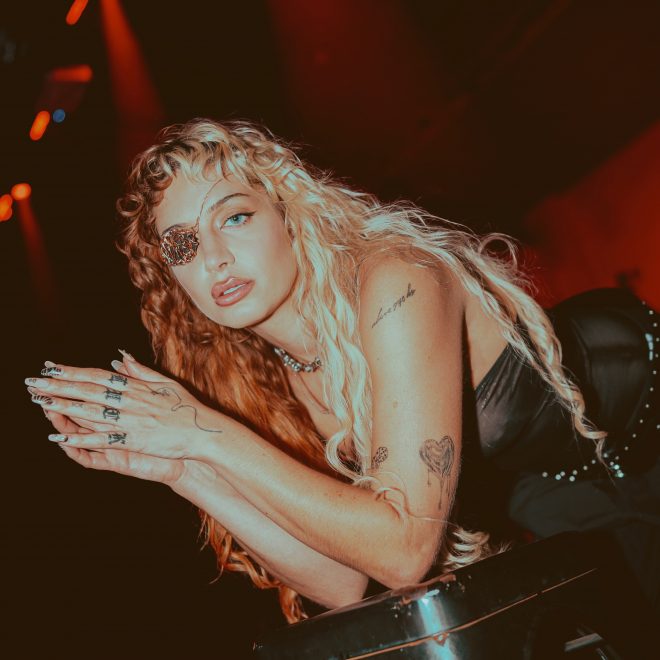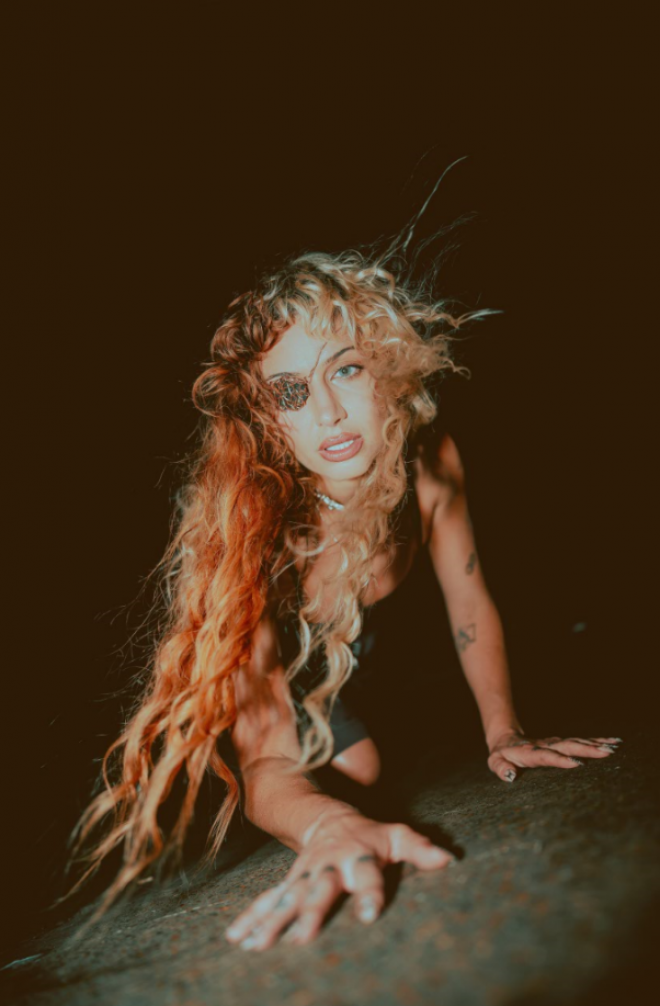Biianco: building gaia, building a world

BIIANCO is not interested in fitting into the mold. From their earliest days on stage to their current place in the intricate dance conversation, they have built a career on refusing to play it safe. For them, music isn’t just a soundtrack to the rave; it’s a platform for identity, resistance, and connection, a way of showing up fully, with flaws, fire, and all.
That drive has crystallized in GAIA, the party they launched this year with a sold-out debut at Corsica Studios. More than a rave, GAIA feels like a manifesto: FLINTA-forward lineups, accessibility built into every detail, and a family-style approach to curation where artists are chosen as much for their integrity as for their ability to light up the dancefloor. It’s loud, unapologetic, and deeply intentional, a reflection of BIIANCO’s own journey as a queer, femme, neurodivergent, and partially blind artist navigating the global scene.
But GAIA is only one side of the story. Behind the booth, BIIANCO putheys just as hard, blurring the line between DJ set and live show with looping, hardware improvisation, and relentless energy. Add to that their obsession with engineering, their roots in classical music, and their determination to use dance culture as a community-building force, and you get the kind of artist ADE exists to celebrate: uncompromising, inventive, and building the future in real time.
If the global rave circuit has sometimes felt predictable, GAIA is BIIANCO’s answer to tearing up the script. Launched with a sold-out night at Corsica Studios and already scaling to Colour Factory and Los Angeles, GAIA is more than just another party series. It’s a blueprint for what the next chapter of high-energy club culture could look like: risk-taking lineups, radical inclusivity, and a sense of belonging that you can feel from the moment you step inside.
“GAIA came out of so many late-night conversations with close friends, usually after playing or raving together, where we’d talk about what was missing in the scene. I wanted to build a night that wasn’t just another club booking, but a real space focused on four things: the most exciting talent in high-energy, hard dance music; FLINTA-forward lineups that go beyond tokenism; a sense of inclusivity that you can actually feel the moment you walk in; and real accessibility for those who are usually left out of nightlife experiences.”
“The name GAIA felt right because it’s about creating a world, not just an event, that nurtures and uplifts. Gaia was the original Greek representation of Mother Earth. The party itself is rooted in joy, connection, and sonic chaos, but also in responsibility to the community. I don’t just want people to dance. I want them to feel like they belong.”
That vision isn’t abstract; it’s built into every layer of the night. BIIANCO’s own lived experience as a queer, femme, disabled artist makes accessibility a non-negotiable.
“As many people know, I became visually disabled after an accident a few years ago, and since then, accessibility in rave spaces has gone from something I never thought about to something that directly shapes how I move through the world. So building a space that’s intentionally inclusive and accommodating wasn’t just a nice-to-have, it was non-negotiable.”
It also appears in the bookings. GAIA lineups prioritize artists whose communities mirror its ethos, creating a space where belonging is more than a slogan.
“All of my most formative rave experiences have taken place in queer, community-focused environments. That’s the blueprint for GAIA. It shows up in who I book, artists whose fanbases and creative energy reflect the exact community I want to build this with. And because I’m queer, femme, and disabled, my fanbase naturally shares those same values, so in a way, this is just an extension of the world we already move in.”

For the Los Angeles edition, the ethos even begins at the door.
“We’ve got an incredible door person who’ll be lightly quizzing people on the party’s ethos before they enter. Think of it like a fun, cheeky remix of the Berghain door, but rooted in values, not exclusivity.”
GAIA is carefully curated like a family tree of disruptors. BIIANCO handpicks artists not just for their DJ skills, but for their vision. “I look for artists who are more than just DJs, they’re visionaries building entire creative ecosystems, both in their sound and in their communities. While the lineups can include cis men, GAIA is intentionally FLINTA-forward. I’m curating a list of people I’d want to collaborate with on music or just cook dinner with on a Tuesday night. These are artists who bring integrity, imagination, and a sense of responsibility to the scene. They’re disruptors at the intersection of art forms.”
“I want people to walk away feeling like they experienced some of the most cutting-edge artists in the most inclusive, intentional environment possible. I want them to feel fully open in the best way, emotionally, physically, and artistically. Like they found a piece of themselves on that dance floor that they didn’t know they were missing. If they leave feeling seen, enriched, and euphoric, then GAIA did what it was supposed to do.”
If GAIA is BIIANCO’s statement to the culture, her DJ sets are where that manifesto comes alive in sound. They’ve built a reputation for risk-taking, weaving live acid 303 improvisations into her mixes and treating the booth like a stage rather than a safety net.
“I come from a live music background. I was a classically trained pianist and spent years playing in bands as a singer, synth player, bassist, drummer, and guitarist before becoming a modular synth-obsessed tech-head. So honestly, getting the live element out of my sets would be harder than putting it in. Even the way I spin leans into that ethos: I often use multiple decks at once, stay super active on the mixes, and approach it like a performance, not just track selection.”
“I’m not interested in passive DJing. I want to challenge any complacency that’s crept into the techno scene and push the boundaries of what a DJ set can feel like. Whether it’s improvising on a 303 live or just treating the decks as an instrument, I want to inspire other DJs to take more risks. Some of my friends, like Serafina, Fumi, and the 240 km/h crew, are, in my opinion, among the most athletic DJs in the world. Being around them has raised the bar for me, and I hope I do the same for others.”
Her viral looping video of “Against The Wall” proved just how magnetic that hands-on approach could be, but for BIIANCO, it was never about chasing virality. “Honestly, I feel fortunate that what I naturally do in the studio, looping, live playing, hands-on performance, is what resonates most with my audience. That video wasn’t calculated at all. I’ve never had an influencer bone in my body, so the only way anything was going to take off was if it involved me literally playing something with my hands.”
What started as instinct has now become their signature move on tour. “Bringing that into the touring space has been such an effortless extension of my sound. Being at the intersection of live hardware and DJing keeps me creatively engaged, and frankly, keeps me from getting bored.”
Their approach is rooted in both engineering and artistry. “I say I’m an engineer first because I’m always trying to build what doesn’t exist yet. If something’s missing from a track or my set, whether it’s a sound, a transition, or a feeling, I won’t go digging for it; I’ll just make it. That mindset of shaping your tools to serve your vision is what being engineer-first means to me. The same goes for performance. If I want a specific moment, I’ll use the gear in front of me, the mixer, the decks, the 303, to sculpt it in real time. It’s less about relying on what’s available and more about constantly innovating with what’s possible.”
That mix of precision and chaos sharpened when they relocated to London, and later Berlin, where the culture transformed them into the artists they are today. “I’ve always loved DJ Gigola’s Live From Earth merch that says ‘I trust the timing of my life’, it perfectly sums up my journey. It wasn’t just that I moved to London; it’s that I arrived there as someone who had grown up in America with a classical music background, spent a decade touring in bands, and was still restless. I hadn’t yet found the sound or scene that really lit me up. But once I got to London with that foundation, everything seemed to click into place.”
Now, Berlin has pushed that even further.
“The line between community and art is so thin in our sound and scene, and we’re constantly in dialogue with other artists. For example, one of my closest Berlin-based friends, DJ and producer KTK and I spent months discussing music over dinner, and now we have a track coming out together next month on Teletech. It’s this kind of artistic synergy that London sparked and Berlin has deepened for me. Music will never be extracted from its cultural context, and dance music is arguably one of the most community-driven contexts in the music world. For me, when community and music are interlinked, my art thrives.”
For some people, the dancefloor is an escape, but for BIIANCO, it’s the opposite. The rave has always been a mirror, a place where they can stand fully in their own skin.
“For me, dance music has never been about escapism; it’s been the exact opposite. It’s been a way to root myself more deeply in who I am. As someone who’s queer, femme, neurodivergent, and partially blind, the dance floor has always felt like a space where I could actually arrive, not disappear. I hope that my music becomes that same kind of grounding force for others, a catalyst for self-definition and unapologetic embodiment, whatever that looks like for them.”
That honesty is why GAIA resonates so fiercely. It isn’t just a party, but a manifesto, a space designed to center the very communities that built dance music from the ground up. And like its founder, GAIA is not static; it’s meant to evolve, to challenge, to morph into whatever the culture needs next.
“Ultimately, I want to be more than just a musician. I aim to create a cultural ecosystem centered around my art. GAIA is the community-driven vehicle for that vision. It’s designed to grow with the people who shape it, to evolve through the energy and input of the trance and hard dance communities. I’m sure it’ll morph into something I can’t even predict, and that’s the point; it’s collaborative by nature. But if I’m manifesting: I see BIIANCO and GAIA at the forefront of high-energy, high-talent, FLINTA-forward rave culture, offering both sonic catharsis and space for those who need a little Mother Earth goddess energy in harder dance sounds.”
In the end, BIIANCO isn’t just throwing parties or dropping tracks. They’re rewriting what it means to belong in electronic music. GAIA is proof that a rave can also be a refuge, a dancefloor that doubles as a manifesto. Their sets carry the same energy: restless, risk-taking, impossible to reduce to background noise. And maybe that’s the point.
They’re not interested in fitting into the industry’s pre-cut boxes. They’re building their own ecosystem, one rooted in queerness, community, and the kind of fearless experimentation that makes a scene feel alive again. If you step into GAIA or one of their sets, you’re not just witnessing another DJ behind decks. You’re stepping into a world where music isn’t escapism but embodiment.
For BIIANCO, the future isn’t about louder kicks or faster BPMs. It’s about building spaces where people can finally feel like themselves, and that might just be the loudest statement of all.


